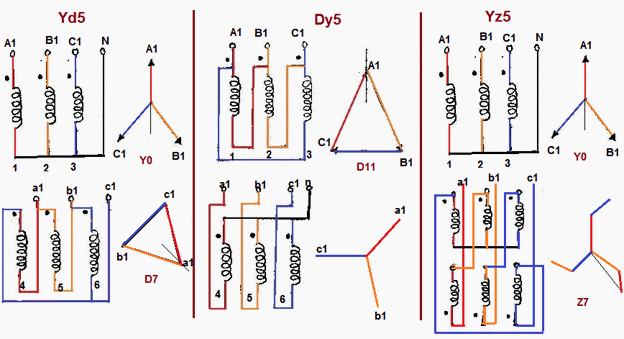Testing Vector Group of Transformer
The proper vector grouping in a transformer is a key criterion for the successful parallel operation of transformers. Therefore, it is important to carry out vector group tests of the transformer at the factory site for ensuring the customer specified vector group of transformers.
The phase sequence or the order in which the phases get their maximum positive voltages must be similar to two paralleled transformers. Otherwise, each pair of phases will be short-circuited during the cycle.
Several secondary connections are available involving different primary three-phase connections in a three-phase transformer. Thus, for the three-phase voltage applied to the same primary, there can be different three-phase secondary voltages with different magnitudes and phases for the various internal connection of transformers.
Let’s discuss in detail by example for better understanding.
It is known that the secondary and primary coils on any one limb have induced EMFs that are in time-phase. It is essential to consider two transformers of the same number primary turn and the primary windings are connected in star.
The secondary number of turns per phase in both transformers is also identical. But the first transformer has delta connected secondary and the other transformer has a star-connected secondary. If voltages applied in the primary of both transformers are similar, the secondary induced emf in each phase will be in the same time-phase as that of the respective primary phase, because the secondary and primary coils of the same phase are wound on the same limb in the core of the transformer.
If the secondary in the first transformer is connected in star, the secondary line voltage is √3 times of induced voltage per secondary phase coil. But the secondary in the second transformer is connected in delta, the line voltage is equal to induced voltage per secondary phase coil. If we pass the vector diagram of secondary line voltages of both transformers, it is easily found that the angular difference between the line voltages of these transformers is 30o.
If these transformers will be run in parallel then there will be a circulating current flow between the transformers as because there is a phase angle difference between their secondary line voltages. This phase difference can not be compensated. Therefore, two sets of connections giving secondary voltages with a phase displacement can not be designed for the parallel operation of transformers.
The below table shows the connections for which from the viewpoint of phase sequence and angular divergences, the transformer can be operated parallel. According to their vector relation, there is different vector group in all three-phase transformers. All electrical power transformers of a particular vector group can easily be operated in parallel if they fulfill other conditions for the parallel operation of transformers.
The procedure of Vector Group Test of Transformer
Let’s have a YNd11 transformer.

- Connect neutral point of star-connected winding with earth.
- Join 1U of HV and 2W of LV together.
- Apply 415 V, three-phase supply to HV terminals.
- Measure voltages between terminals 2U-1N, 2V-1N, 2W-1N, which means voltages between each LV terminal and HV neutral.
- Also measure voltages between terminals 2V-1V, 2W-1W, and 2V-1W.
For the YNd11 transformer, we will find,
2U-1N > 2V-1N > 2W-1N
2V-1W > 2V-1V or 2W-1W .
The vector group test of the transformer for another group can also be done in a similar way.





